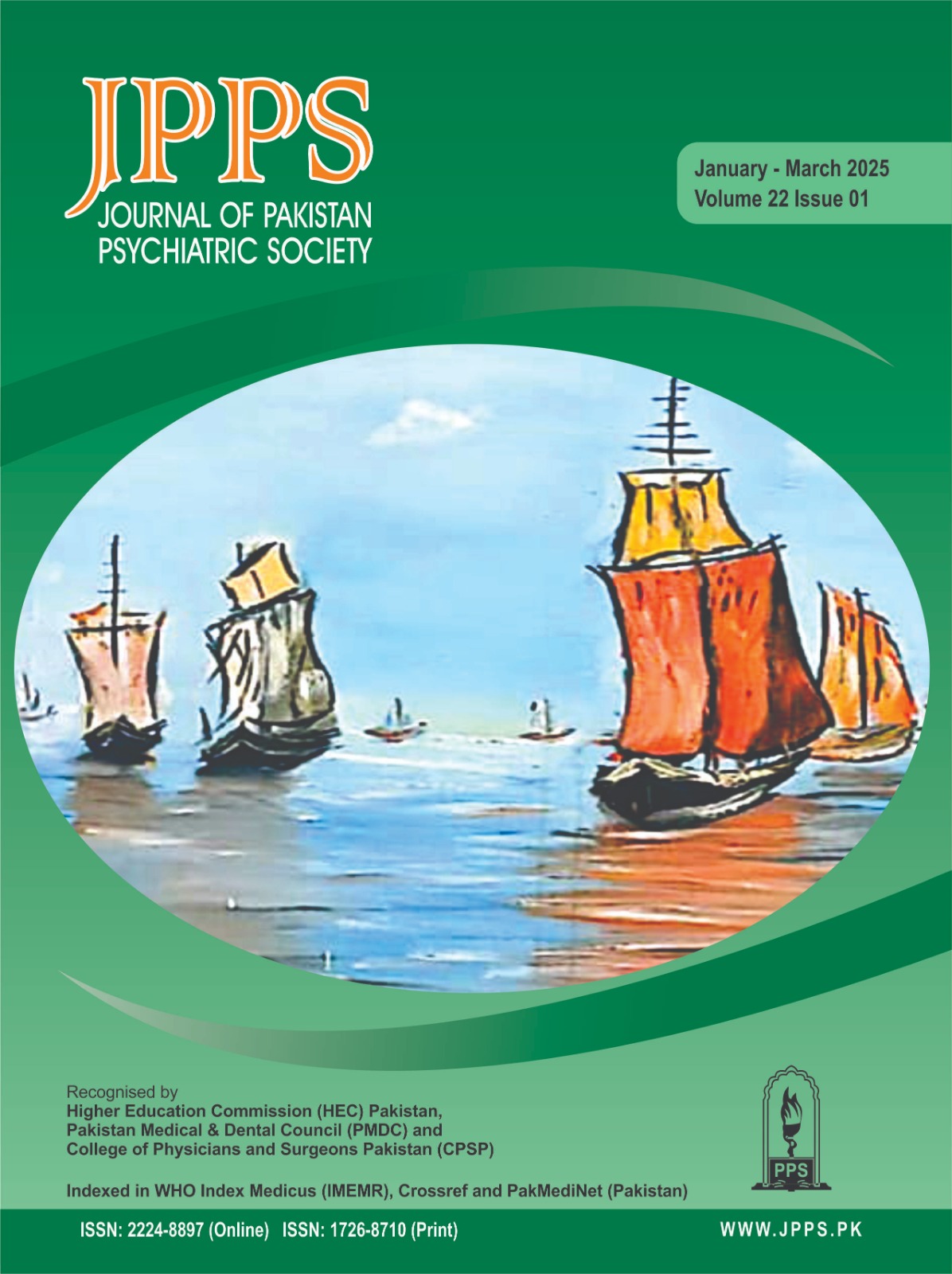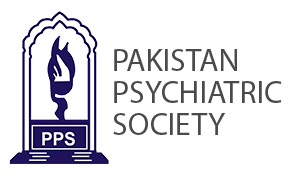FREQUENCY AND ASSOCIATION OF COGNITIVE DYSFUNCTION IN SCHIZOPHRENIA: A CROSS-SECTIONAL STUDY FROM A TERTIARY CARE HOSPITAL IN PAKISTAN
Abstract
OBJECTIVE
To assess the frequency of cognitive impairment and sociodemographic association among patients with schizophrenia presenting to a tertiary care hospital in Pakistan.
STUDY DESIGN
Descriptive cross-sectional study
PLACE AND DURATION OF STUDY
Outpatient Department of Psychiatry at Dr Ruth K.M. Pfau. Civil Hospital Karachi, Pakistan. The duration of the study was 6 months from February 6, 2020, to August 5, 2020.
METHOD
One hundred thirty patients with schizophrenia were assessed using the Urdu version of Montreal cognitive assessment questionnaire.
RESULTS
out of the 100 patients, 66 had significant cognitive impairment accounting for more than half of the study population at 50.8%. Age, duration of illness and gender showed significant association with cognitive dysfunction in these patients.
CONCLUSION
Cognitive dysfunction is a frequent finding in patients with schizophrenia. Future research is needed to investigate the factors increasing its risk.
KEYWORDS
Cognition; Memory; Outpatients; Pakistan; Schizophrenia; Tertiary Care Centres.
Downloads
References
2. James SL, Abate D, Abate KH, Abay SM, Abbafati C, Abbasi N, et al. Global, regional, and national incidence, prevalence, and years lived with disability for 354 diseases and injuries for 195 countries and territories, 1990-2017: a systematic analysis for the global burden of disease study 2017. Lancet. 2018;392:1789–858.
3. Hegarty JD, Baldessarini RJ, Tohen M, Waternaux C, Oepen G. One hundred years of schizophrenia: a meta-analysis of the outcome literature. Am J Psychiatry. 1994;151:1409–16.
4. Picchioni, M. M., & Murray, R. M. (2007). Schizophrenia. BMJ (Clinical research ed.), 335(7610), 91–95. https://doi.org/10.1136/bmj.39227.616447.BE
5. Patel, K. R., Cherian, J., Gohil, K., & Atkinson, D. (2014). Schizophrenia: overview and treatment options. P & T : a peer-reviewed journal for formulary management, 39(9), 638–645.
6. Lopez, O. L., Kuller, L. H., Becker, J. T., Dulberg, C., Sweet, R. A., Gach, H. M., & Dekosky, S. T. (2007). Incidence of dementia in mild cognitive impairment in the cardiovascular health study cognition study. Archives of neurology, 64(3), 416–420. https://doi.org/10.1001/archneur.64.3.416
7. Sharma, T., & Antonova, L. (2003). Cognitive function in schizophrenia. Deficits, functional consequences, and future treatment. The Psychiatric clinics of North America, 26(1), 25–40. https://doi.org/10.1016/s0193-953x(02)00084-9
8. McEvoy J. P. (2007). The costs of schizophrenia. The Journal of clinical psychiatry, 68 Suppl 14, 4–7.
9. Majid Z, Haider A, Kapadia HF. The unique presentation of self-harm-a case report from a developing country.Professional Med J 2016;23(06):760-2.
10. Sekar, A., Bialas, A. R., de Rivera, H., Davis, A., Hammond, T. R., Kamitaki, N., Tooley, K., Presumey, J., Baum, M., Van Doren, V., Genovese, G., Rose, S. A., Handsaker, R. E., Schizophrenia Working Group of the Psychiatric Genomics Consortium, Daly, M. J., Carroll, M. C., Stevens, B., & McCarroll, S. A. (2016). Schizophrenia risk from complex variation of complement component 4. Nature, 530(7589), 177–183. https://doi.org/10.1038/nature16549
11. Cosgrove, D., Harold, D., Mothersill, O., Anney, R., Hill, M. J., Bray, N. J., Blokland, G., Petryshen, T., Wellcome Trust Case Control Consortium, Richards, A., Mantripragada, K., Owen, M., O'Donovan, M. C., Gill, M., Corvin, A., Morris, D. W., & Donohoe, G. (2017). MiR-137-derived polygenic risk: effects on cognitive performance in patients with schizophrenia and controls. Translational psychiatry, 7(1), e1012. https://doi.org/10.1038/tp.2016.286
12. Takahashi, S., Keeser, D., Rauchmann, B. S., Schneider-Axmann, T., Keller-Varady, K., Maurus, I., Dechent, P., Wobrock, T., Hasan, A., Schmitt, A., Ertl-Wagner, B., Malchow, B., & Falkai, P. (2020). Effect of aerobic exercise combined with cognitive remediation on cortical thickness and prediction of social adaptation in patients with schizophrenia. Schizophrenia research, 216, 397–407. https://doi.org/10.1016/j.schres.2019.11.004
13. Heinrichs, R. W., & Zakzanis, K. K. (1998). Neurocognitive deficit in schizophrenia: a quantitative review of the evidence. Neuropsychology, 12(3), 426–445. https://doi.org/10.1037//0894-4105.12.3.426
14. Reichenberg, A., Weiser, M., Caspi, A., Knobler, H. Y., Lubin, G., Harvey, P. D., Rabinowitz, J., & Davidson, M. (2006). Premorbid intellectual functioning and risk of schizophrenia and spectrum disorders. Journal of clinical and experimental neuropsychology, 28(2), 193–207. https://doi.org/10.1080/13803390500360372
15. Arunpongpaisal S, Sangsirilak A. Using MoCA-Thai to evaluate cognitive impairment in patients with schizophrenia; 2013.
16. Keefe, R. S., Eesley, C. E., & Poe, M. P. (2005). Defining a cognitive function decrement in schizophrenia. Biological psychiatry, 57(6), 688–691. https://doi.org/10.1016/j.biopsych.2005.01.003
17. Goit, B. K. ., & Khattri, J. B. (2019). Prevalence of Working Memory Impairment in Drug Naive Schizophrenic Patients in a Tertiary Care Hospital. Journal of Nepal Medical Association, 57(219). https://doi.org/10.31729/jnma.4642
18. Fujino, H., Sumiyoshi, C., Yasuda, Y., Yamamori, H., Fujimoto, M., Fukunaga, M., Miura, K., Takebayashi, Y., Okada, N., Isomura, S., Kawano, N., Toyomaki, A., Kuga, H., Isobe, M., Oya, K., Okahisa, Y., Takaki, M., Hashimoto, N., Kato, M., Onitsuka, T., … for COCORO (2017). Estimated cognitive decline in patients with schizophrenia: A multicenter study. Psychiatry and clinical neurosciences, 71(5), 294–300. https://doi.org/10.1111/pcn.12474
19. Wu, J. Q., Chen, D. C., Tan, Y. L., Xiu, M. H., De Yang, F., Soares, J. C., & Zhang, X. Y. (2016). Cognitive impairments in first-episode drug-naive and chronic medicated schizophrenia: MATRICS consensus cognitive battery in a Chinese Han population. Psychiatry research, 238, 196–202. https://doi.org/10.1016/j.psychres.2016.02.042
20. Jones, P., Rodgers, B., Murray, R., & Marmot, M. (1994). Child development risk factors for adult schizophrenia in the British 1946 birth cohort. Lancet (London, England), 344(8934), 1398–1402. https://doi.org/10.1016/s0140-6736(94)90569-x
21. Kahn RS, Keefe RSE. Schizophrenia Is a Cognitive Illness: Time for a Change in Focus. JAMA Psychiatry. 2013;70(10):1107–1112. doi:10.1001/jamapsychiatry.2013.155
22. Keefe R. S. (2008). Should cognitive impairment be included in the diagnostic criteria for schizophrenia?. World psychiatry : official journal of the World Psychiatric Association (WPA), 7(1), 22–28. https://doi.org/10.1002/j.2051-5545.2008.tb00142.x
23. Balu, D. T., & Lucki, I. (2009). Adult hippocampal neurogenesis: regulation, functional implications, and contribution to disease pathology. Neuroscience and biobehavioral reviews, 33(3), 232–252. https://doi.org/10.1016/j.neubiorev.2008.08.007
24. Elder, G. A., De Gasperi, R., & Gama Sosa, M. A. (2006). Research update: neurogenesis in adult brain and neuropsychiatric disorders. The Mount Sinai journal of medicine, New York, 73(7), 931–940.
25. Gourion, D., Gourevitch, R., Leprovost, J. B., Olié H lôo, J. P., & Krebs, M. O. (2004). L'hypothèse neurodéveloppementale dans la schizophrénie [Neurodevelopmental hypothesis in schizophrenia]. L'Encephale, 30(2), 109–118. https://doi.org/10.1016/s0013-7006(04)95421-8
26. Voineskos, D., Rogasch, N. C., Rajji, T. K., Fitzgerald, P. B., & Daskalakis, Z. J. (2013). A review of evidence linking disrupted neural plasticity to schizophrenia. Canadian journal of psychiatry. Revue canadienne de psychiatrie, 58(2), 86–92. https://doi.org/10.1177/070674371305800205
27. Nieto, R., Kukuljan, M., & Silva, H. (2013). BDNF and schizophrenia: from neurodevelopment to neuronal plasticity, learning, and memory. Frontiers in psychiatry, 4, 45. https://doi.org/10.3389/fpsyt.2013.00045
28. Formoso, K., Billi, S. C., Frasch, A. C., & Scorticati, C. (2015). Tyrosine 251 at the C-terminus of neuronal glycoprotein M6a is critical for neurite outgrowth. Journal of neuroscience research, 93(2), 215–229. https://doi.org/10.1002/jnr.23482
29. Stephan, K. E., Friston, K. J., & Frith, C. D. (2009). Dysconnection in schizophrenia: from abnormal synaptic plasticity to failures of self-monitoring. Schizophrenia bulletin, 35(3), 509–527. https://doi.org/10.1093/schbul/sbn176
30. Toulopoulou, T., Goldberg, T. E., Mesa, I. R., Picchioni, M., Rijsdijk, F., Stahl, D., Cherny, S. S., Sham, P., Faraone, S. V., Tsuang, M., Weinberger, D. R., Seidman, L. J., & Murray, R. M. (2010). Impaired intellect and memory: a missing link between genetic risk and schizophrenia?. Archives of general psychiatry, 67(9), 905–913. https://doi.org/10.1001/archgenpsychiatry.2010.99
31. Toulopoulou, T., Picchioni, M., Rijsdijk, F., Hua-Hall, M., Ettinger, U., Sham, P., & Murray, R. (2007). Substantial genetic overlap between neurocognition and schizophrenia: genetic modeling in twin samples. Archives of general psychiatry, 64(12), 1348–1355. https://doi.org/10.1001/archpsyc.64.12.1348
32. Kraepelin E (1971) In: Robertson GM, ed. Dementia praecox and paraphrenia. Melbourne, FL: Robert E. Krieger
33. Seidman, L. J., Kremen, W. S., Koren, D., Faraone, S. V., Goldstein, J. M., & Tsuang, M. T. (2002). A comparative profile analysis of neuropsychological functioning in patients with schizophrenia and bipolar psychoses. Schizophrenia research, 53(1-2), 31–44. https://doi.org/10.1016/s0920-9964(01)00162-1
34. Mohamed, S., Paulsen, J. S., O'Leary, D., Arndt, S., & Andreasen, N. (1999). Generalized cognitive deficits in schizophrenia: a study of first-episode patients. Archives of general psychiatry, 56(8), 749–754. https://doi.org/10.1001/archpsyc.56.8.749
Copyright (c) 2025 Journal of Pakistan Psychiatric Society

This work is licensed under a Creative Commons Attribution-NonCommercial 4.0 International License.
Copyright © JPPS. Published by Pakistan Psychiatric Society
Licensing: This work is licensed under Creative Commons Attribution-NonCommercial 4.0 International License
Readers may “Share-copy and redistribute the material in any medium or format” and “Adapt-remix, transform, and build upon the material”. The readers must give appropriate credit to the source of the material and indicate if changes were made to the material. Readers may not use the material for commercial purposes. The readers may not apply legal terms or technological measures that legally restrict others from doing anything the license permits.






.png)









